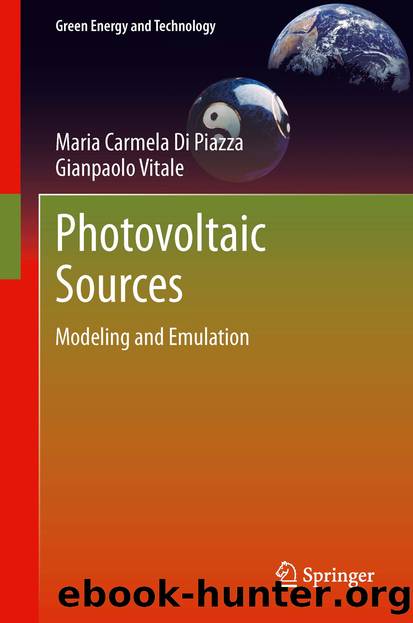Photovoltaic Sources by Maria Carmela Di Piazza & Gianpaolo Vitale

Author:Maria Carmela Di Piazza & Gianpaolo Vitale
Language: eng
Format: epub
Publisher: Springer London, London
The output voltage derivative of this circuit is given by:
(5.1)
where V = V mod = V load when the switch is closed. Hence, by measuring I load and the voltage derivative during a suitable transient and by using the model expressed by (3.12) for achieving the corresponding values of I mod(V), the value of C could be calculated by least square regression (LSR).
It can be observed that it is cumbersome to acquire the voltage signal and to perform a post-processing derivative, since it will be affected by noise.
Moreover, the circuit drawn in Fig. 5.1 is not sufficiently accurate to model the electrical dynamic behavior of a PV module because, although the effect of the capacitance is predominant, other effects are present which are not negligible.
Firstly, the junction capacitance effect implies the presence of a conductance 1/R c , whose time constant reproduces the time needed by the quantity of charge in the capacitance to vary according to the variation of the junction voltage. Moreover, a further effect given by the connection parasitic inductance is to be expected due to the cables connecting the cells and the whole source to the load. This value is higher when a series connection of PV cells is exploited to obtain a higher V oc. Due to these reasons, when a resistive load is abruptly connected to a PV module, the load current is expected to have a second-order circuit response and the module voltage an exponential decay that depends on all the three resistances: R s , R c , and R L . The equivalent dynamic circuit, including a switch to verify the load insertion, is given in Fig. 5.2. On the contrary, the model sketched in Fig. 5.1 gives a first-order response for voltage and current: in particular, an exponential decay that depends on R s and R L is obtained.
Fig. 5.2The complete equivalent circuit of a PV module
Download
This site does not store any files on its server. We only index and link to content provided by other sites. Please contact the content providers to delete copyright contents if any and email us, we'll remove relevant links or contents immediately.
Algorithms of the Intelligent Web by Haralambos Marmanis;Dmitry Babenko(8522)
Test-Driven Development with Java by Alan Mellor(7393)
Data Augmentation with Python by Duc Haba(7296)
Principles of Data Fabric by Sonia Mezzetta(7040)
Learn Blender Simulations the Right Way by Stephen Pearson(6977)
Microservices with Spring Boot 3 and Spring Cloud by Magnus Larsson(6799)
RPA Solution Architect's Handbook by Sachin Sahgal(6210)
Hadoop in Practice by Alex Holmes(6031)
The Infinite Retina by Robert Scoble Irena Cronin(5909)
Jquery UI in Action : Master the concepts Of Jquery UI: A Step By Step Approach by ANMOL GOYAL(5873)
Big Data Analysis with Python by Ivan Marin(5717)
Life 3.0: Being Human in the Age of Artificial Intelligence by Tegmark Max(5402)
Pretrain Vision and Large Language Models in Python by Emily Webber(4679)
Infrastructure as Code for Beginners by Russ McKendrick(4460)
WordPress Plugin Development Cookbook by Yannick Lefebvre(4192)
Functional Programming in JavaScript by Mantyla Dan(4124)
The Age of Surveillance Capitalism by Shoshana Zuboff(4116)
Embracing Microservices Design by Ovais Mehboob Ahmed Khan Nabil Siddiqui and Timothy Oleson(3976)
Applied Machine Learning for Healthcare and Life Sciences Using AWS by Ujjwal Ratan(3954)
